A cub’s life
For a bear, survival in its first year of life depends entirely on the protection and teachings of its mother.
A cub lives its first moments in the hibernation den in the heart of winter between December and February.
Although the temperatures outside may be bitterly cold, as low as 20 degrees centigrade below zero, the cubs enjoy more comfortable conditions, thanks to the well-insulated cavity chosen by their mother and the warmth of her body. At birth, the cubs weigh no more than 350-500 grams, one twentieth of their mother’s weight. They come into the world blind, toothless and hairless, but within a few weeks they are covered with soft fur and can double in weight, thanks to their mother’s nutritious and particularly fat-rich milk. Numerous factors can affect the outcome of a pregnancy, including the mother’s health, disturbance of the animals in their den or the female’s genetic make-up. There is a fear that the low genetic variability of bears in the Apennines may contribute to reducing the fertility of the females, causing abortions or making the newborn cubs more fragile.
The days of observation mount up in the memory. Long hours in wait, scouring every boulder, every shrub, the edges of the forest and the ridges with meticulous persistence. The light marked the passage of time, changing the silhouettes of trees and rocks. The “ti..ti..ti” of the kestrels and the stones rolling under the deer’s hooves helped keep my attention focussed. At dawn, when the torpor of the night gave way to the first warm rays of the sun, my eyes became weak and tired. On the coldest days, the body demanded movement, but went unheeded. Week after week, my shoulders shrunk under the weight of my rucksack and, day after day, my legs grew lazy in always reaching the same destination. And then that constant dithering dance with the rain, the wind, the lightning and the fog. The waiting, the fleeing, the sheltering. Sometimes you felt so foreign, sometimes so part of it all. But then you stayed there, you came back, you waited, because the clouds disappeared, because the light entwined with the fog, because everything went quiet. Always on the lookout for that moment, that instant, that quickened pulse, those words whispered in your head. Hand on the binoculars, point of reference, eye on the scope. 19.30, female with two young. Each time, witnessing the emergence of the year’s first bear cubs is a profound emotion. In this small Apennine population, every birth brings hope for the future.
Elisabetta
A female and her young cubs emerge for the first time from the den in late May.
Fat females generally give birth earlier, produce more milk and are able to suckle for longer. Cubs born to these mothers will grow faster and weigh more at the same age, so they will be stronger than the others. On the other hand, in thin females, implantation of the foetus may not even take place. If they do give birth, these females will produce less milk and will be forced to reduce the intensity and duration of suckling for some or all of the young, to the detriment of their size. Right from birth, cubs compete with each other for the best feed. Cubs raised alone can be up to 30% heavier than those raised with siblings.
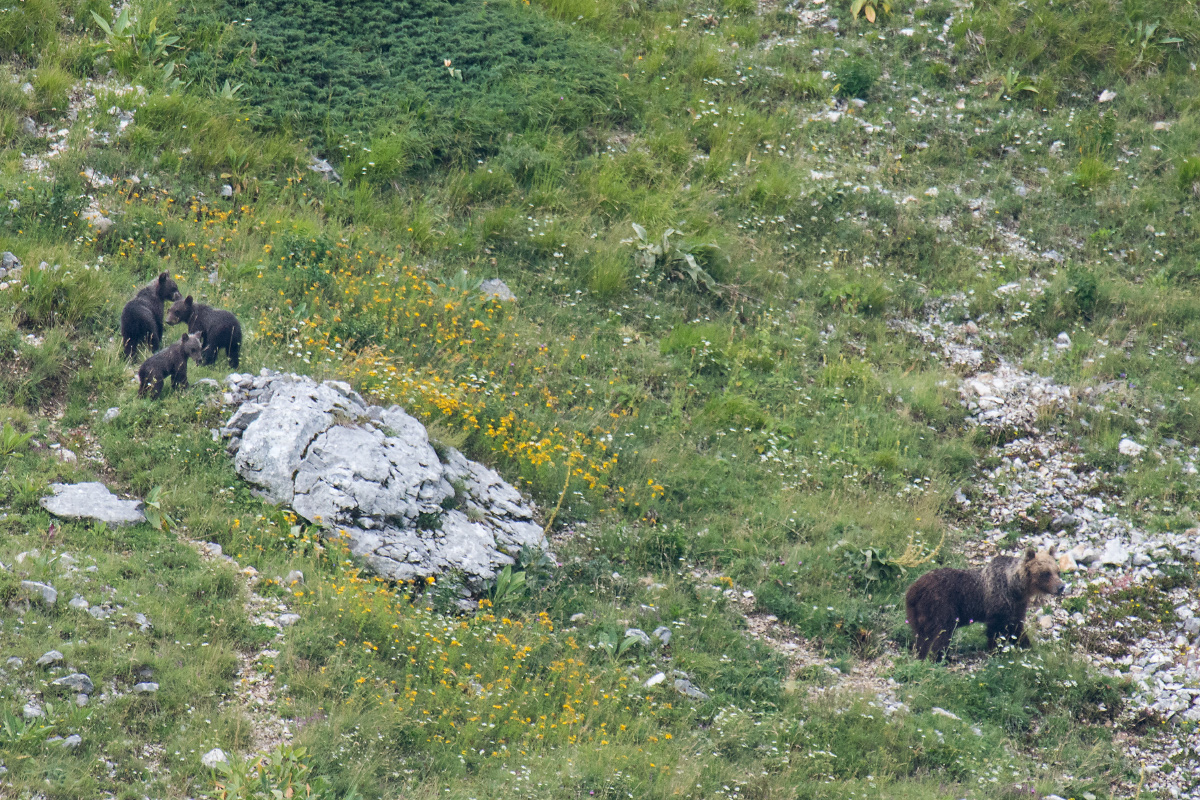
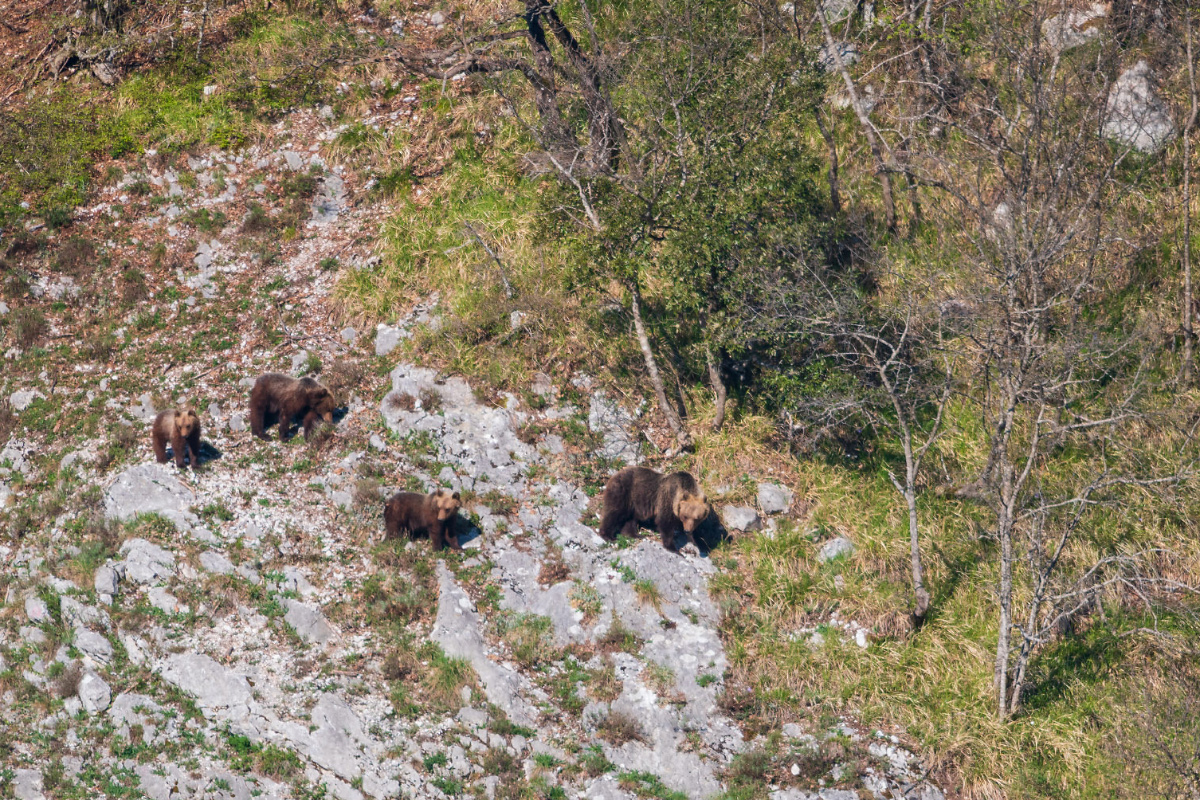
This female was first observed in summer 2018 with three cubs, one clearly much smaller than the others. The survival of the tiniest seemed at risk, but it adopted the strategy of always remaining at its mother’s side. By the following spring, although still different in size, all the cubs were still alive and together with their mother.
From the very first exploratory outings, the day of a family group of bears revolves around a few basic activities: eating, moving around, resting and, when possible, playing.
In bears, the female is the sole provider of parental care and cubs spend their first few months carefully observing the behaviour of their teacher. She teaches them what to eat and where to find it, how to choose refuge areas and dens and how to behave with other bears or other animals. For these animals, life is not just about instinct, but is based on a long, first year of instruction and learning. Between May and July, families spend long hours bending tree branches to eat the first leaves, grazing or rummaging under rocks for insects. At first, the cubs imitate their mother’s movements, but as if it were all a game. They do acrobatics on the branches and lift up stones to make them roll. But over time, they come to associate their mother’s behaviour with food and no longer miss a morsel. Females may suckle their cubs until the spring after their birth, but usually after a few months they have already started to experiment with solid food and by autumn they are fully weaned. As well as eating, young bears spend a lot of time playing with each other and when there is just one cub, it is the mother who devotes most time to this activity. Play is a training ground for life and playing is a guarantee of survival.
Two cubs begin their first explorations outside the den between play, discovery and imitation of their mother’s behaviour.
While the cubs learn through play, the females spend a whole year protecting them with determination and courage. The mother’s age and experience play a key role in the survival of the litter.
Primiparous (giving birth to cubs for the first time) or very old females may be more likely to lose sight of one of their cubs. The mother must keep an eye on her cubs at all times and, through distraction or curiosity, there is always one who lags behind, especially in large litters. In addition, the females have to face many dangers every day and overcoming these demands experience, determination, perseverance and strength. The mothers are, in fact, always very cautious when out and about with their young. If a mother moves, she constantly seeks the cubs’ attention with vocalisations and if one of them lags behind for too long, she goes back to retrieve it. Sometimes she may leave the cubs on their own to scout out another area before reuniting the family. If she feels threatened or is separated from one of her cubs, such as during an attack by another bear or a wolf, or if cornered by people or vehicles, a female bear can become extremely aggressive. In these situations, she is visibly torn between the need to find her offspring and the need to defend them. She looks for them by sniffing the ground like a bloodhound, or rearing up to sniff the air. She moves nervously in all directions, making feint attacks towards the potential danger. It is in the case of a violent confrontation with an adult male bear that a female may lose her life. In the Apennines, there have been two cases of females found dead during the breeding season, partially eaten and probably killed by another bear, their nipples still with milk residues.
I saw the first bear cub of my life on the afternoon of 31 July 2006. I watched it for almost three hours and was surprised and worried that it was alone. It was very strange. I had read that a mother never stays away from a cub for that long, especially in areas where several bears congregate, such as alpine buckthorn scrub. The week before, in that very same place, I had observed five bears at the same time. But the cub seemed calm as it wandered around the margin between the woodland and the buckthorn bushes. Every now and then, it would approach a bush, bend its branches and rummage through the leaves. It skilfully grasped a berry between its lips without tearing a single leaf. Every so often, it would go higher and a branch would give way under the weight of its body, causing it to fall to the ground in an explosion of leaves. With human apprehension, I watched the cub as night drew on, wondering what had happened to the mother. As soon as the sun went down, a motionless, statuesque, seated silhouette appeared behind him, sniffing the air in my direction. Of course the mother had been there all along, hiding in the shadows, watchful and alert.
Elisabetta
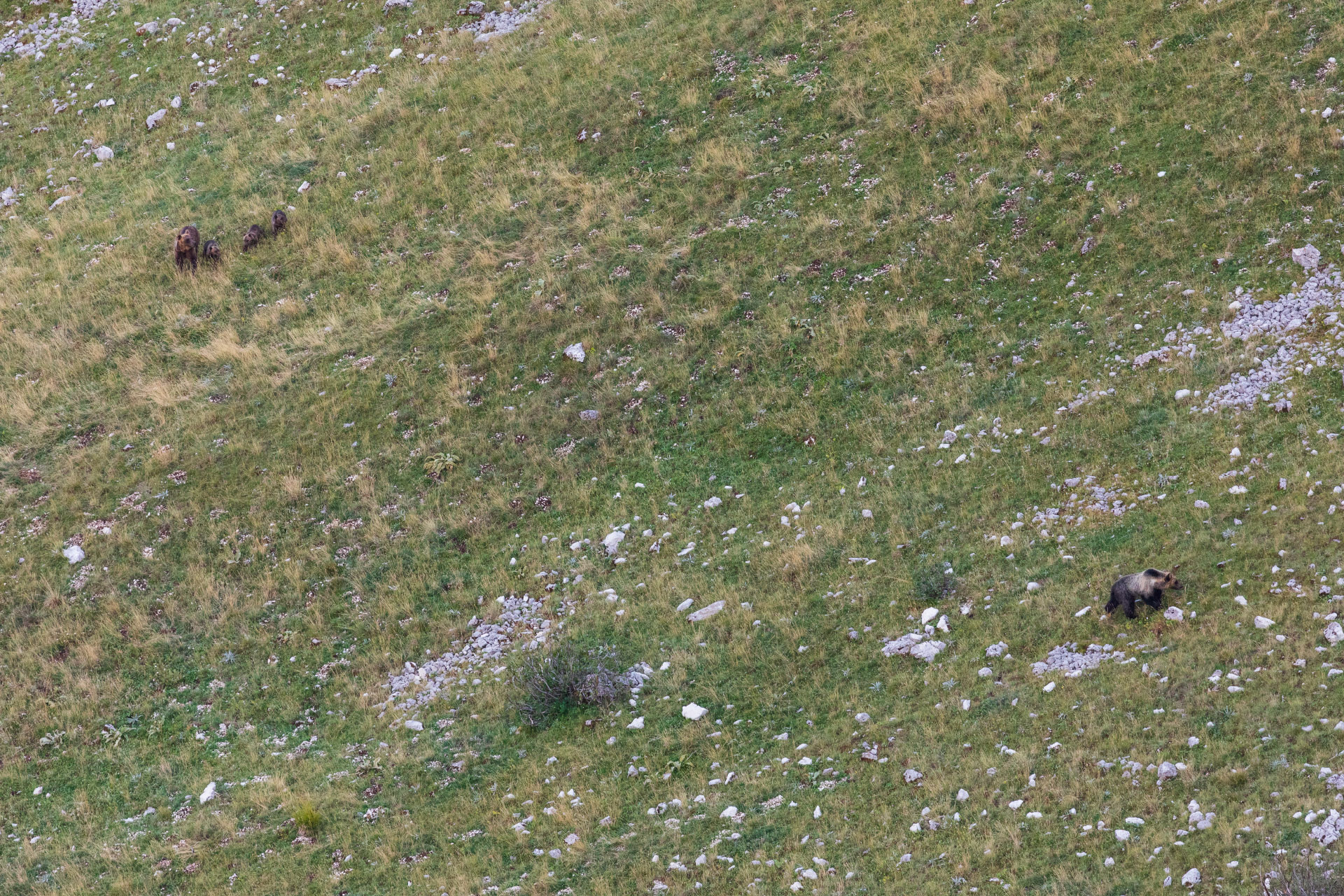
A female accompanied by two year-old cubs confronts an adult male who has come too close.
Despite their mother’s care, young bears remain the weakest link in the population until they are two years old. They may be killed by other bears, orphaned or driven away from food-rich areas.
In the Apennines, only half the cubs reach their second year of life. But even from their second summer when the youngsters are now on their own, the risks to these animals do not diminish. Established causes of mortality include disease, predation by dogs, aggression by adult males and poisoning. Bear cubs can also be orphaned for a variety of reasons, such as their mother’s death, her abandonment (for example, if she is disturbed in the den), or following traumatic natural events (for example, if the family group is attacked by a male). What are the chances of a cub surviving without its mother? Studies confirm that a cub may already be self-sufficient by about seven months old. In environments where food is easy to find, a cub of this age has as much chance of survival as one that has not been separated from its mother. Orphans may also be adopted by another family group, or join together to form “gangs”. For bears in the Apennines, 2019 was a special year, as nine litters for a total of 16 cubs were observed. But it is also the year when four orphaned cubs were found. In two cases, at least one of the cubs was reunited with the original family group or was adopted, while the other two were never seen again. In two cases, the cause of the abandonment was established: in one case, the mother was hit by a vehicle, in the other, the family was chased by a vehicle of curious onlookers.
An orphan in the Abruzzo National Park
On the night of 24 August 2019, while crossing the outskirts of Pescasseroli, the female F08, known to the Park’s technicians and researchers since 2008, was chased with her three cubs by a vehicle of curious onlookers. The next day, two of her young were seen together in the centre of the village searching for their mother, but they were separated by groups of people who followed them on foot. The female bear was later observed on several occasions, including during the day, moving around in the vicinity of Pescasseroli in search of her cubs. Unfortunately she only found one. There was no trace of the third. In this population, each individual is precious and can contribute to preservation of the species. It is therefore essential to prevent premature abandonment of cubs by their mothers for non-natural, human-associated causes. By correcting our behaviour and avoiding approaching the animals or chasing them by car, we can avoid jeopardising their tranquillity
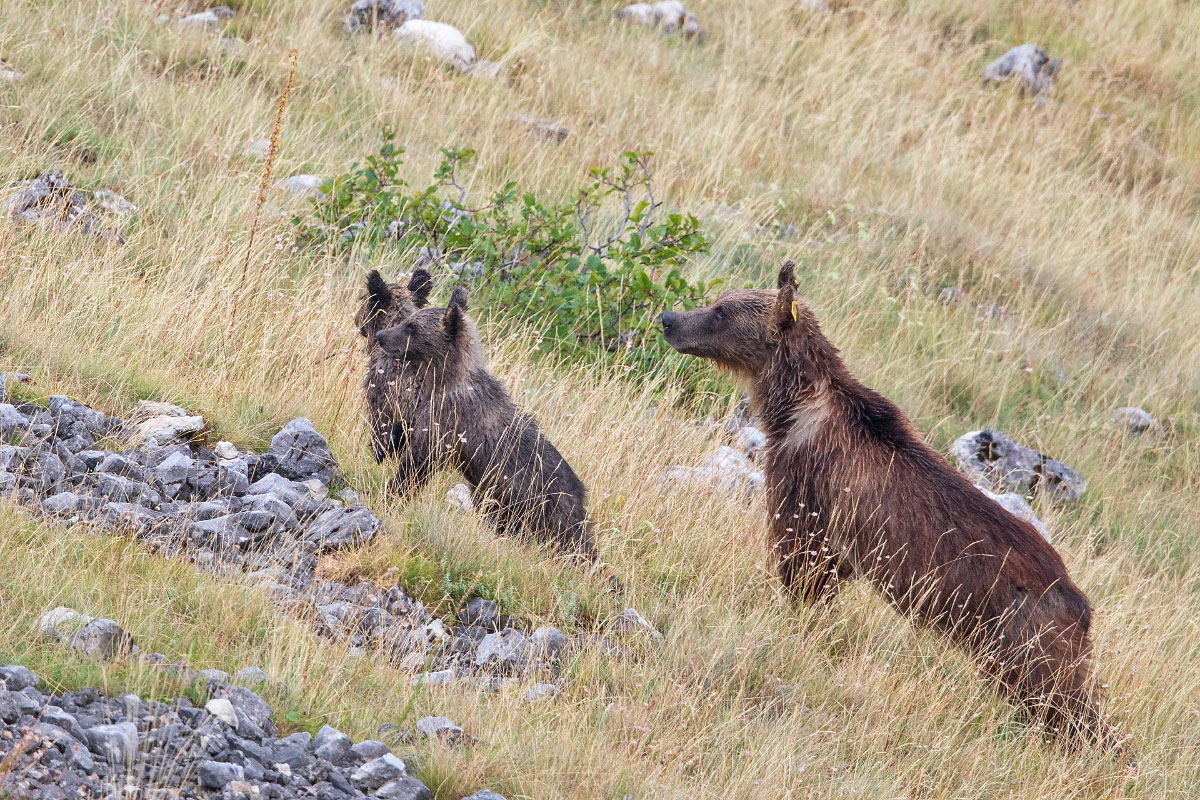
In the Apennines, a female may very rarely spend a second summer, or even a third winter, with her cubs. In general, however, she drives them away when they are about a year and a half old.
Separation from the mother occurs between the first week of May and early June of their second year of life, peaking at the end of May, coinciding with the breeding season. In most cases the separation is triggered by the approach of a male wanting to mate. But if a mother drives the cub away, it is because she believes it is now able to fend for itself and there is enough food around for it to survive. If this is not the case, the female may keep her offspring with her for a further year. The separation is not painless for the youngsters, but it happens very quickly, within a few days. In the case of litters with two or three cubs, the siblings may, however, remain together for some time: strength in numbers. After the separation, some cubs try to rejoin their mother, sometimes throughout the entire summer. Occasionally they may be successful, but on most occasions it is the female herself who aggressively drives her young away.
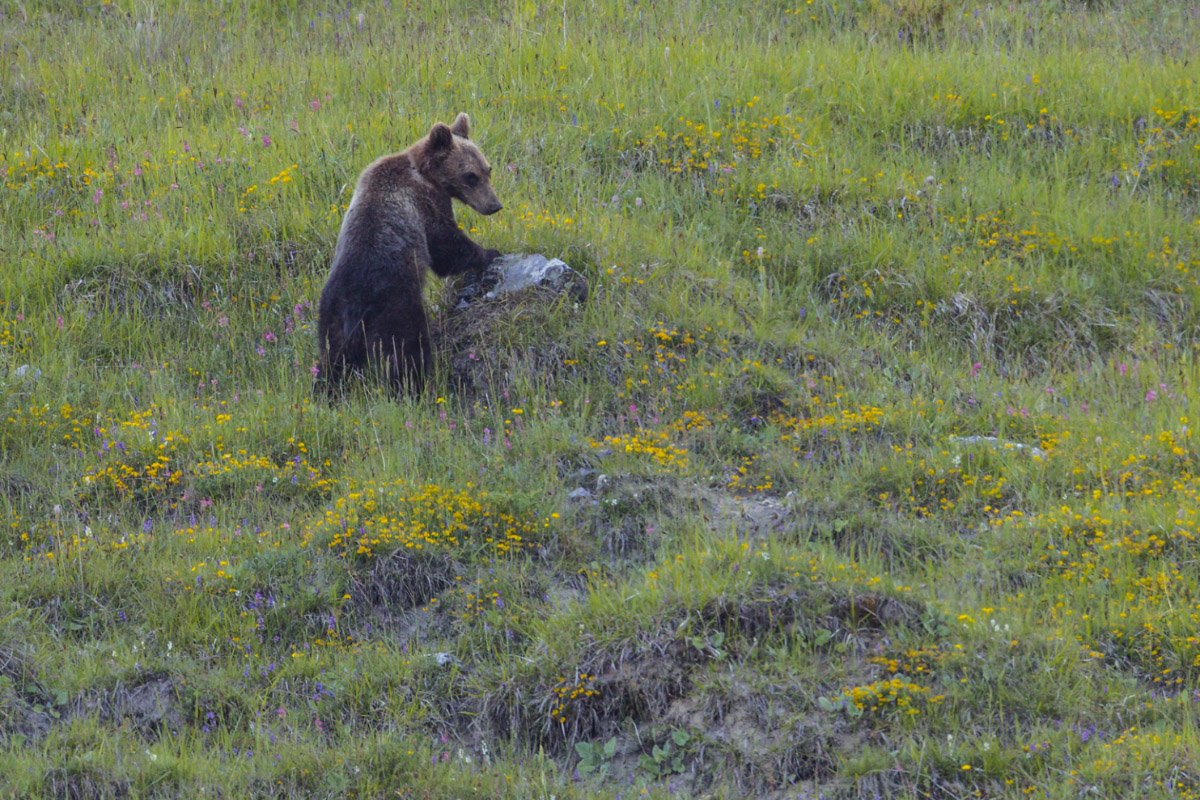
For a year and a half, this cub has been living under its mother’s protective wing. Now on its own, it has to put all its mother’s teachings into practice and learn to play a strategic game in the adult world.
The need to reduce competition for food and a mate, but especially the need to avoid inbreeding, induces the young bears to move away from their place of birth. But some prefer to enjoy all the comforts of a familiar place.
Staying or leaving is a dilemma that the young males and females all face during their early years. Playing on their home pitch, in other words, remaining in a territory where they know every blade of grass, is very advantageous for a female who must stay fit and healthy in order to reproduce. Of course there is always the risk of mating with a blood relative, such as the father. But this can be avoided, as there are always many other males around and the females have learned to distinguish them. The contraindications come in the form of dominant female relatives, such as the mother, who may force younger females not to reproduce. In short, if you stay, you have to know how to wait your turn. Female bears are ultimately highly philopatric and therefore tend to occupy the same territory as their mother, forming a kind of matriarchal “society”. Staying is so tempting that, according to studies conducted in Scandinavia, young females find themselves competing with each other. Who wins? The fatter ones, while the thinner ones are forced to leave. Philopatry is, on the other hand, also a strength, as it enables a female in dispersal to originate new micro-populations by keeping her daughters close. On the other hand, evolution has programmed all young males to move away from their natal territory. The need to find new females to mate with is stronger than any homesickness.
If they do stray, female brown bears stay within a few dozen kilometres of their home territory, while males may move even hundreds of kilometres away.
Yet the choice is not always so obvious. In high density areas, regardless of their sex, bears may delay their departure, or reduce their dispersal distances. There is indeed a real risk of being attacked by other bears when crossing unknown or densely occupied territories. So the compromise is to remain subordinate in exchange for less stress. However, even dominant animals may make an exception to the rule. Helping a blood relative is, after all, a way of protecting your own genealogy. At low densities, on the other hand, a dominant has no choice but to drive away any potential competitors in reproduction. And then again, when there are only a few females available, the only possibility for a young male who wants to mate is to emigrate and this, at the end of the day, is an advantage for everyone.
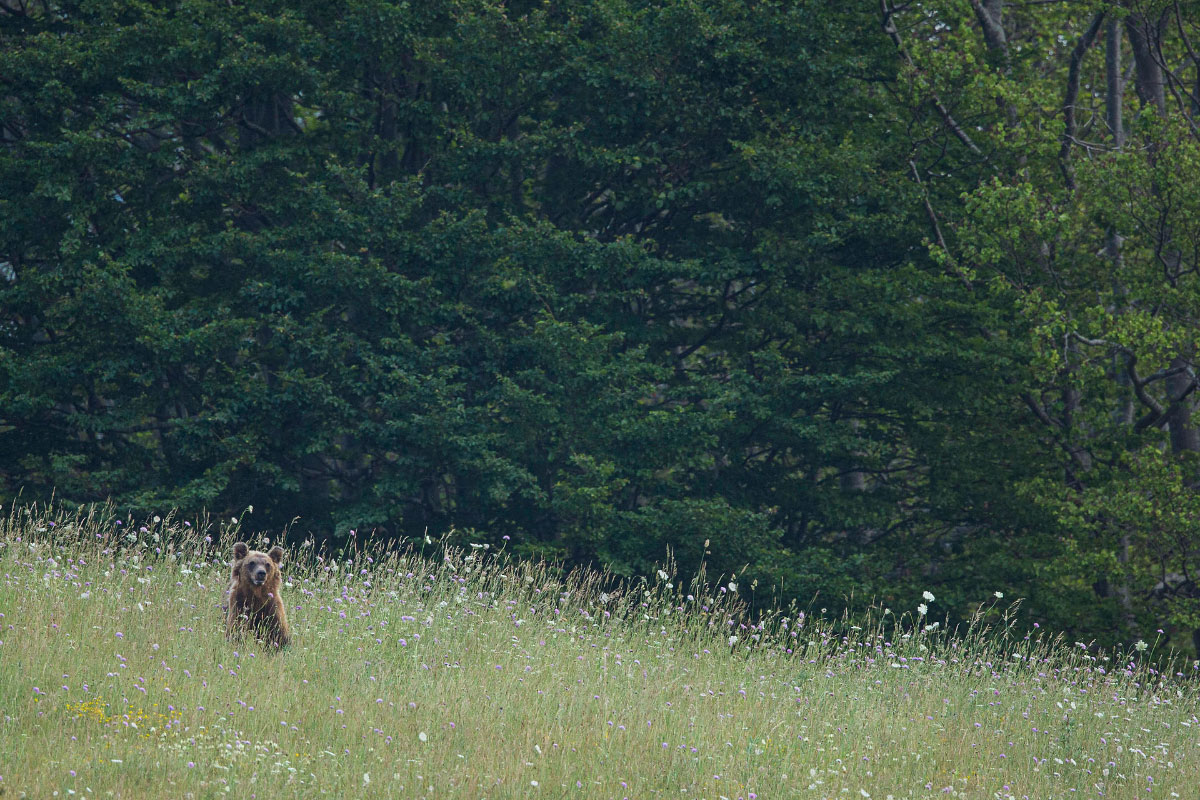
A young bear moves with caution in a clearing at the edge of the beech forest. Animals on dispersal must face uncertainties, novelties and dangers in order to find a new territory.
In the central Apennines, young males in dispersal can travel hundreds of kilometres in even a very short time. With more than 5,000 km2 of suitable territory available, the Apennines have plenty of space for these animals and also food to make them strong and fit. On the other hand, the females in these areas can be counted on the fingers of one hand and if the males want to mate, the only solution is to go back to where females are more abundant.
The bears’ natural need to roam new territories in search of females and a home multiplies the risks of some fatalities. Bears cannot find the solution, but perhaps we humans might.

